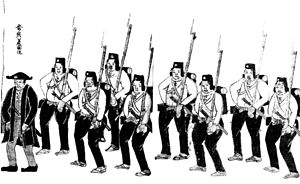The Mito rebellion (水戸幕末争乱, Mito bakumatsu sōran), also called the Kantō Insurrection or the Tengutō Rebellion (天狗党の乱, tengutō no ran), was a civil war that occurred in the area of Mito Domain in Japan from May 2, 1864 to January 14, 1865. It involved an uprising and terrorist actions against the central power of the Shogunate in favour of the sonnō jōi ("Revere the emperor, expel the barbarians") policy.[3]
Quick Facts Mito rebellion 水戸幕末争乱, Date ...
Mito rebellion
水戸幕末争乱 |
|---|
| Part of Bakumatsu conflicts |

Shogunate troops moving to quell the Mito rebellion in 1864.

"Takeda Kōunsai at Mt. Tsukuba" by Utagawa Kuniteru III |
| Date | May 2, 1864 – January 14, 1865
(8 months, 1 week and 5 days) |
|---|
| Location | Eastern Japan |
|---|
| Result |
Shogunate victory |
|---|
|
| Belligerents |
|---|
|
|
|
| Commanders and leaders |
|---|
|
|
|
| Strength |
|---|
|
2,000 |
About 10,000 |
| Casualties and losses |
|---|
|
About 1,300 rebels killed, around 353 were executed, and 100 died in captivity |
Around 6,700 shogunate members killed |
Close
A shogunal pacification force was sent to Mount Tsukuba on 17 June 1864, consisting of 700 Mito soldiers led by Ichikawa, with 3 to 5 cannons and at least 200 firearms, as well as a Tokugawa shogunate force of 3,000 men with over 600 firearms and several cannons.[4]
As the conflict escalated, on 10 October 1864 at Nakaminato, the shogunate force of 6,700 was defeated by 2000 insurgents, and several shogunal defeats followed.[5]
The insurgents were weakening, however, dwindling to about 1,000. By December 1864 they faced a new force under Tokugawa Yoshinobu (himself born in Mito) numbering over 10,000, which ultimately forced them to surrender.[6]
The uprising resulted in 1,300 dead on the rebels' side, which suffered vicious repression, including 353 executions and approximately 100 who died in captivity.[7]

